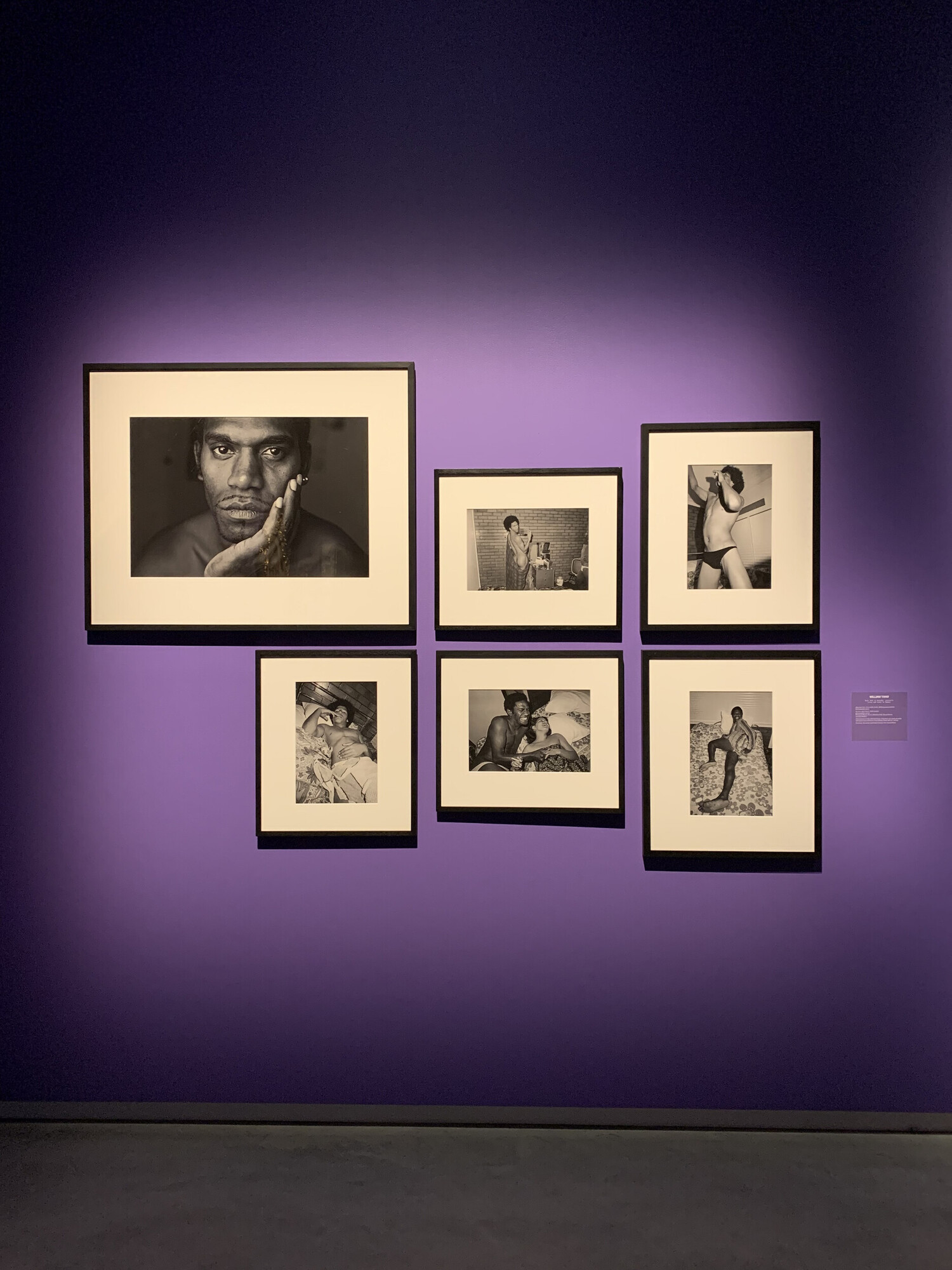Left to right: William Yang, selection from On tour after hours, 1976 (series); Forward to the Dreamtime performance. Sydney Opera House, 1976 (series); Workshop by Erik Mariko, Arthur Keibsu and Peter Kikaki, Glebe Studios, 1976 (series). Courtesy the artist and State Library New South Wales © William Yang. Installation view, 24th Biennale of Sydney, Ten Thousand Suns, 2024, Chau Chak Wing Museum, University of Sydney. Photograph: David James.
The 24th Biennale of Sydney: Ten Thousand Suns
Lachlan Thompson
Cosmin Costinaş and Inti Guerrero’s rhetoric for Ten Thousand Suns initially reads like a conspiracy, which goes something like this: Capitalists and colonial powers want us to imagine the world is heading towards its inevitable demise! A politics of joy, on the other hand, is more open and hopeful; to borrow a term from theorist Eve Sedgwick, it’s reparative.
The joy–doom binary has the potential to be heavy-handed. In the Biennale, if a work doesn’t give joy, it is often juxtaposed with something that does (another artwork, an archive). Here, the supposed delightfulness of a positive feeling is always meant to be the more radical proposal. But things aren’t as simple or divisive as they first appear. In working through the joy–doom binary, Costinaş and Guerrero seek to offer historical depth to the dialectical relationship of these two affective forces. They historicise joy, giving it temporal layers and weaving it into the textures of trauma. One of the notable ways they do this is by invoking the archives of specific historical events.

Left to right: William Yang, Malcolm Cole. Circa 1976, Glebe, 1976 (reprinted 2024). selection from On tour after hours, 1976 (series). Courtesy the artist and State Library New South Wales © William Yang. Installation view, 24th Biennale of Sydney, Ten Thousand Suns, 2024, Chau Chak Wing Museum, University of Sydney. Photograph: Lachlan Thompson.
Mardi Gras is one of the key historical registers for Ten Thousand Suns, and within this Biennale focus, the curators have sought to memorialise and invoke the legacy of Malcolm Cole. A First Nations dancer and choreographer, Cole was a founding member of AIDT (Aboriginal/Islander Dance Theatre) and a martyr of the HIV/AIDS crisis. His image appears at White Bay Power Station on a monitor showing video footage of his performance as Captain James Cook at the 1988 Mardi Gras, which took place the year of Australia’s Bicentenary. Also at White Bay, Cole stands tall, like a giant, in an enormous mural by Dylan Mooney, referencing Cole’s performance as Cook. Cole is also at Chau Chak Wing Museum via Yang’s striking photography. We see Cole up close, gently looking back at the camera, and hanging out with members of ADIT in a hotel room while on tour. They’re laughing in bed together, looking over their shoulder at the camera and, evidently, Yang, who captures the moment. The photos are effortless and playfully performative. You can imagine it was late, and their laughter could be heard down the hall and on the floor above.
Like Cole, Yang is an anchor for the Biennale, showing at three of the six exhibiting locations (excluding the Sydney Opera House). Yang’s practice traverses many historical, affective, and political registers that the Biennale hopes to encompass. The histories that his work traces branch out from his grandparents’ migration to Australia in the 1880s, through the violence faced by his family, through the HIV/AIDS crisis in Sydney, and his work with Aboriginal and Torres Strait Islander artists.

William Yang, Publicity Photographs for Nigeria tour #1-#21, 1976. Courtesy the artist and The State Library of NSW, Sydney © William Yang. Installation view, 24th Biennale of Sydney, Ten Thousand Suns, 2024, White Bay Power Station. Photograph: Document Photography
Yang’s work at White Bay Power Station, Publicity Photographs for Nigeria tour #1–#21, consists of three screens cycling through publicity photos he took of AIDT in 1976 as they prepare to travel to Nigeria for FESTAC ‘77. The presentation references Yang’s slideshows, a cornerstone of his practice. The didactic stands to the right, below the screens. While I’m sure the placement is merely a curatorial compromise, it reads as if we are being encouraged to view the images as historical objects rather than a few paces back at normal viewing distance for one of Yang’s slideshows. The work is placed in an entryway to one of the main rooms or caverns of White Bay Power Station. There isn’t anywhere to sit or stand to watch, but I find a spot against a handrail. I can hear a busload of people arriving outside. The images show five dancers laughing, rehearsing, performing for the camera, dressing, and painting each other. Yang’s portraits of the performers are stunning, and show this staunch history of joy, at once a practising of and preparation for the celebration. There’s a crowd streaming in from outside. I’m getting in the way and must move on.

William Yang, Publicity Photographs for Nigeria tour #1-#21, 1976. Courtesy the artist and The State Library of NSW, Sydney © William Yang. Installation view, 24th Biennale of Sydney, Ten Thousand Suns, 2024, White Bay Power Station. Photograph: Document Photography
Working from archives and histories in Australia means grappling with the inherently biased source material. To restate the trouble of this joy–doom binary, it’s difficult to imagine the bliss, happiness, ecstasy, delight, etcetera, in Australia without it being flattened through its proximity to colonial histories or a disregard for the violent material conditions of the colony. Ten Thousand Suns’s approach to history branches out from legacies such as Cole’s and Yang’s. Getting your bearings amongst these threads and retellings that move across different works and sites can be difficult. Costinaş and Guerrero approach joy, its archives, and histories by tracing its contingent coexistence with catastrophe; the complexity of historical events is carefully drawn out through the feelings and imaginings of beamingly defiant histories and futures.
Lachlan Thompson is an artist and writer based on Cammeraygal and Gadigal land.


